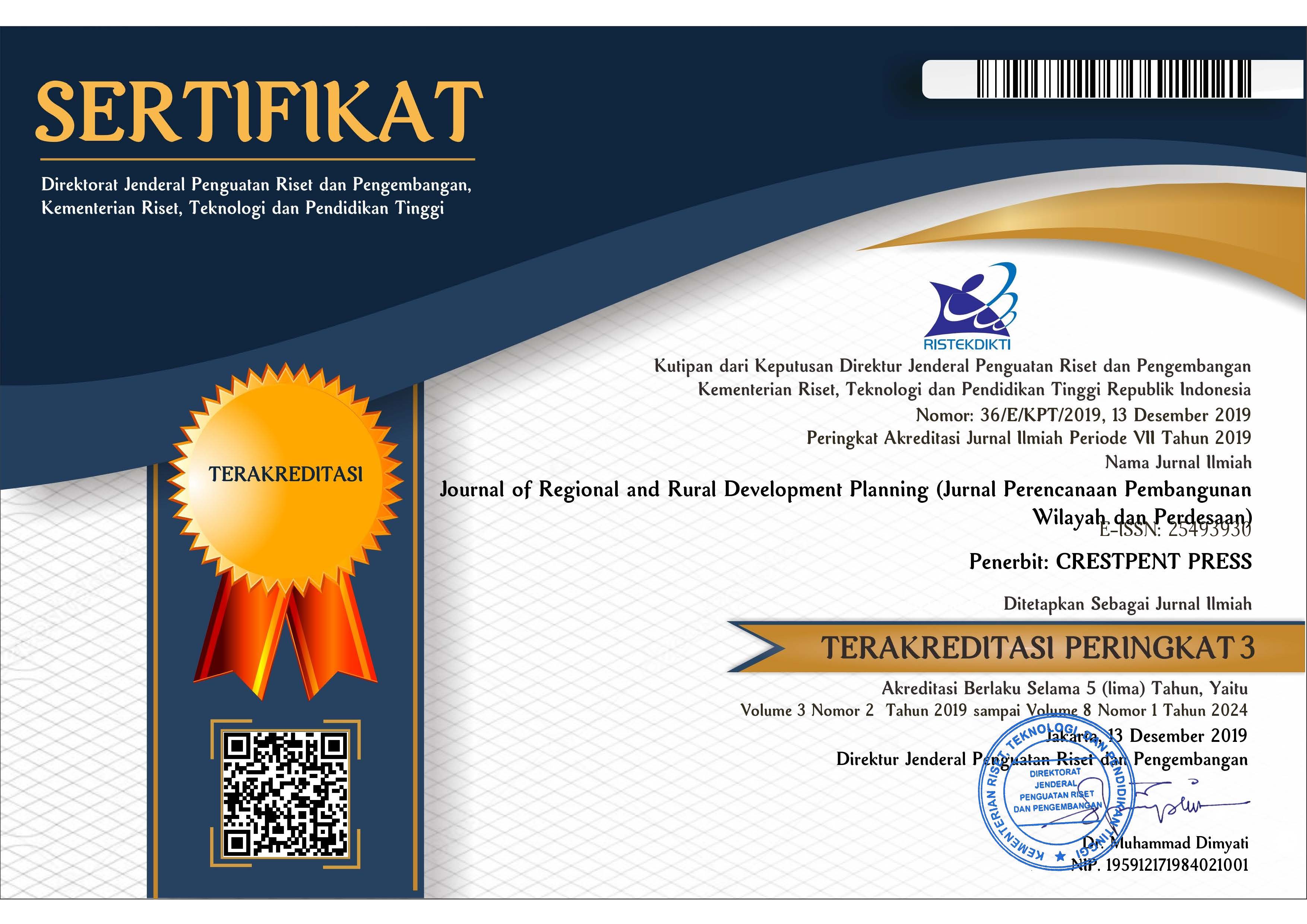Pola Spasial Pergeseran Pusat Pertumbuhan Desa di Kabupaten Kulon Progo
Abstract
Kulon Progo is a poorest district and has the highest development inequality in Daerah Istimewa Yogyakarta (DIY) based on Badan Pusat Statistik (BPS) publication. The local government has made various efforts to overcome the problems, one of which is by establishing growth centers since 2003. However, Kulon Progo Regency has experienced rapid development with the existence of Yogyakarta International Airport, which affected the dynamics of regional growth centers. The purpose of this study is to identify the potential Rural Growth Center (PPD) and identify the spatial patterns of PPD shifts in Kulon Progo to see the trickle down effect. This study used descriptive quantitative methods using scalogram index, centrality index, urban network analysis, and gravity index, also moran’s I index and Local Indicator Of Spatial Association (LISA). The results showed that there was a shift in rural growth centers, but the spatial analysis did not show any trickle down effect from rural growth centers that had been formed before. However, new centers were formed that were not related to the previous rural growth centers. These results indicates that the rural growth centers in Kulon Progo cannot have a growth effect on the surrounding area.
References
Anselin, L. (2019). The Moran Scatterplot as an ESDA Tool to Assess Local Instability in Spatial Association. In M. M. Fischer (Ed.), Spatial Analytical Perspectives on GIS. Taylor & Francis.
Bere, R. C., Otoiu, A., & Bucerzan, I. (2014). Determinants of economic growth in cities acting as growth poles in regions from Romania. Procedia Economics and Finance, 10, 357–365.
Brittas, A. (2021). Historical Aspects of Eradication of Poverty Action. In L. W. Filho, A. M. Azul, L. Brandli, A. Lange Salvia, P. G. Ozuyar, & T. Wall (Eds.), No Poverty. Springer.
Burrough, P. A., McDonnell, R. A., & Lloyd, C. D. (2015). Principles of Geographical Information Systems. Oxford University Press.
Caloffi, A., & Serra, M. (2022). Revisiting Perroux ’ s development poles : the cases of Italy and Brazil. Texto Para Discussao, n(425), 1–23.
Cattaneo, M., Morlotti, C., Malighetti, P., & Redondi, R. (2023). Airports and population density: where benefits outweigh costs. Regional Studies, 57(3), 576–589.
Chi, G. (2012). The impacts of transport accessibility on population change across rural, suburban and urban areas: A case study of Wisconsin at sub-county levels. Urban Studies, 49(12), 2711–2731.
Chi, G., & Zhu, J. (2019). Spatial Regression Models for the Social Sciences. SAGE Publications.
Dall’erba, S., & Chen, Z. (2019). Exploratory Spatial Data Analysis. In International Encyclopedia of Human Geography (pp. 357–365). Elsevier Science.
ESCAP. (1980). Regional Development Strategy for the 1980s. Economic and Social Survey of ASIA and the Pacific 1979.
Fatimah, S. (2020). Teori Perencanaan. Uwais Inspirasi Indonesia.
Hasna, M., & Qibti, M. (2020). Analisis spillover effect pertumbuhan ekonomi antar kabupaten/kota di Kawasan Purwomanggung Jawa Tengah tahun 1988-2018. Journal of Economics, 9(4), 1–15.
Hidayat, W. (2017). Perencanaan Pembangunan Daerah: Pendekatan Pertumbuhan Ekonomi, Disparitas Pendapatan dan Kemiskinan. UMM Press.
Hirschman, A. (1958). The Strategy of Economic Development. Yale University Press.
Indira, A., & Chandrasekaran, N. (2023). Infrastructure development in India: a systematic review. Letters in Spatial and Resource Science, 16(35), 1–12.
Indriyani, R. A. A., & Widaningrum, D. L. (2021). A spatial equity assessment of the public facilities in the greater Jakarta area using Moran’s i spatial autocorrelation. IOP Conference Series: Earth and Environmental Science, 794(1).
Kumar, P. (2019). The dimensions of Indian rural development : issues and challenges. Think India Journal, 22(12), 600–610.
Mahi, A. K., & Trigunarso, S. I. (2017). Perencanaan Pembangunan Daerah: Teori dan Aplikasi. Kencana.
Mutaali, L. (2015). Teknik Analisis Regional: Untuk Perencanaan Wilayah, Tata Ruang dan Lingkungan. Badan Penerbit Fakultas Geografi.
Pang, J., Shen, S., & Zhou, N. (2024). The Spillover effect of government relocations on economic growth in Chinese cities. Journal of Economic Behavior and Organization, 222(71903145), 104–122.
Paraskevopoulos, Y., & Photis, Y. N. (2020). Finding Centrality : Developing GIS-Based Analytical Tools for Active and Human-Oriented Centres. Computational Science and Its Applications - ICCSA 2020, March, 577–592.
Perroux, F. (1950). Economic space: theory and applications. The Quarterly Journal of Economics, 64(1), 89–104.
Pratiwi, M. C. Y., & Kuncoro, M. (2016). Analisis pusat pertumbuhan dan autokorelasi spasial di Kalimantan: Studi empiris di 55 kabupaten/kota, 2000-2012. Jurnal Ekonomi Dan Pembangunan Indonesia, 16(2), 81–104.
Prihantono, G., Subandriyo Putri, H. E., & Sabilau, O. G. (2022). Spillover effects or endowment factors caused regional inequality in Gresik District? East Java Economic Journal, 6(1), 111–125.
Rahadini, A. (2023). Identifying Growth Pattern as Regional Classification in Central Java and Yogyakarta. IOP Conference Series: Earth and Environmental Science, 1203(1).
Rahajeng, A., Jaya, W. K., Pangaribowo, E., & Darwin, M. (2023). Transformation of yogyakarta regional development: a shifting perception of economic power among the regions. GeoJournal, 88(2), 1671–1686.
Sari, G. N., & Wahed, M. (2023). Analisis spillover effect pertumbuhan ekonomi kabupaten/kota di Wilayah Bakorwil V Jember Jawa Timur menggunakan analisis VECM. Jurnal Ekonomi, Manajemen, Dan Akuntansi, 9(4), 1265–1275.
Sharma, P. K. (2020). Spatial analysis of rural growth centres in Sagar District, Madhya Pradesh. Journal of Global Resources, 6(01), 110–117.
Stiglitz, J. E., Sen, A., & Fitoussi, J.-P. (2011). Mengukur Kesejahteraan. Marjin Kiri.
Tobler, W. (1970). A computer movie simulating urban growth in the Detroit region. Economic Geography, 46, 234–240.
Verma, S., Chatterjee, A., & Mandal, N. R. (2017). Analysing urban sprawl and shifting of urban growth centre of Bengaluru City, India using shannon’s entropy method. Journal of Settlements and Spatial Planning, 8(2), 89–98.
Wang, F., Zhang, Y., Tisdell, C., & Liu, H. (2021). Progress in reducing the poverty of ethnic minority groups in China. In Social Economics, Policy and Development.
Wibisono, P., & Kuncoro, M. (2015). Efek limpahan pertumbuhan antar-kabupaten/kota di Provinsi Jawa Timur tahun 2001–2013. Jurnal Ekonomi Dan Pembangunan Indonesia, 16(1), 31–46.
Wijaya, O., Susanto, D. A., Heruwarsi, T., Giyanti, S., & Ibrahim, N. R. N. (2021). Decomposition of the Theil Index in Inequality Analyses in Yogyakarta Indonesia. E3S Web of Conferences, 316, 1–15.
Xiong, C., Beckmann, V., & Tan, R. (2018). Effects of infrastructure on land use and land cover change (LUCC): The case of Hangzhou International Airport, China. Sustainability, 10, 2–18. https://doi.org/doi:10.3390/su10062013
Zhao, L., Yang, L., & Chang, X. (2024). Spatial network characteristics and economic effects of element flow in the Lanxi urban agglomeration. PLoS ONE, 19(5), 1–14.
Copyright (c) 2024 Journal of Regional and Rural Development Planning (Jurnal Perencanaan Pembangunan Wilayah dan Perdesaan)

This work is licensed under a Creative Commons Attribution-ShareAlike 4.0 International License.




.png)














